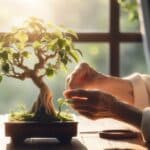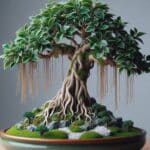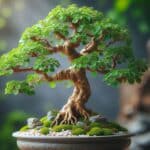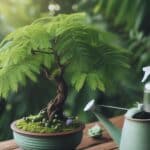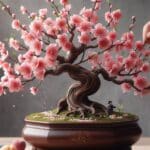If you want to grow a bonsai tree that not only has attractive, interesting roots and elegant foliage but also a unique aroma to enjoy, you might want to consider growing the lemon cypress tree bonsai.
Lemon cypress, or Cupressus macrocarpa, is technically a form of Monterey cypress, producing lovely yellow-green foliage that smells, as you might expect, just like lemons! All you need to do is run your fingers over the foliage to enjoy the heavenly scent.
A plant that does well when grown indoors, lemon cypress tree bonsai is one of the easiest bonsai plants to cultivate.
Interesting Facts about Lemon Cypress Bonsai
| Height | 19-20” |
| Width | 12-14” |
| Sunlight | Full sun |
| Flowering Time Length | N/A |
| Lifespan | 5-10 years indoors, sometimes longer outside |
| Scientific Name | Cupressus macrocarpa |
The foliage of the Lemon Cypress Bonsai tree is a striking bright, lemon-lime green color, which makes it a visually appealing feature in any bonsai collection. This distinctive brilliant light green color tends to be more intense at the tips of the branches and can provide a stunning contrast to the darker greens of other plants or bonsai.
As for the smell, as its common name implies, the foliage has a delightful citrusy fragrance. When the foliage is touched or brushed against, it releases a strong distinctly lemon aroma. This refreshing aroma makes it a popular choice not only for bonsai but also for indoor pot plants or outdoor garden landscapes.
Growing Lemon Cypress Plant from Seed or by Propagation
You can propagate your bonsai from seed or by cuttings with relative ease. However, it’s often easier to purchase this bonsai specimen as a starter plant from a nursery specializing in bonsai plants.
How to Care for Lemon Cypress Tree Bonsai
Here are some indoor and outdoor bonsai tree care tips you can follow:
Sunlight
Lemon cypress tree, like most Monterey cypress trees, is sensitive to any amount of shade. These plants thrive in USDA zones 7-10, so crave warmth and sunlight. If growing this plant outdoors, make sure it’s growing in a warm area. If growing indoors, a sunny location is important. Turn the container regularly to make sure each side gets adequate sunlight – it needs at least six to eight hours of light per day.
In the winter, you can drop the temperatures for your bonsai, but not too much. Drop the thermostat to around 60 degrees, which will mimic the dormant period outdoors yet not be so cold that your tree suffers as a result.
Watering
Lemon cypress trees are thirsty plants that need lots of water in order to stay healthy. In fact, if you aren’t diligent about watering your tree, you’ll likely find that the needles turn brown and lose their wonderful fragrance. Water whenever the soil feels dry to the touch.
Fertilizing
You don’t need to fertilize often – usually just once in the spring is enough to encourage a new flush of growth. Use a slow-release 20-20-20 fertilizer to do this just before new growth starts to appear.
Potting and Repotting
These trees have strong growth so they will need to be repotted relatively early, since the roots become thick in a hurry. Fortunately, these roots tend to be somewhat soft so you shouldn’t have a hard time pruning them. Repot a young tree every two years. For older trees, you can wait three to five years.
Pruning Lemon Cypress Tree Bonsai
You can shorten new shoots of your bonsai plant as soon as they start to produce lateral ramification. Wait until this point because if you prune the shoots too early, they sometimes die back in the fall. You can prune and train branches in fall or early spring.
Pests and Diseases
There are no known pests or diseases for indoor-grown lemon cypress.
Where to Buy Lemon Cypress Tree Bonsai
Of course, you can always buy a lemon cypress tree from your local gardening store or tree nursery, but you may have better luck purchasing this bonsai tree from a store that specializes in lemon cypress tree bonsais or similar bonsai species.
By doing this, you’re more likely to receive a tree that’s acclimated to life in a container, meaning you’ll have fewer problems keeping it alive later on down the road.
See more: Bald cypress bonsai care
*image by serezniy/depositphotos


